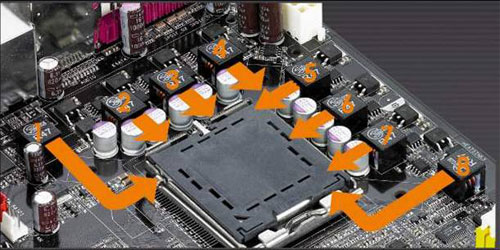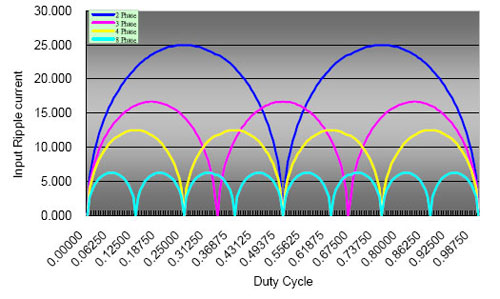Asus A8N32-SLI Deluxe: NVIDIA Dual x16 for the Athlon 64
by Wesley Fink on November 6, 2005 9:00 AM EST- Posted in
- Motherboards
8-Phase Power and Dual x16 PCIe
Two areas really stand out with the new Asus A8N32-SLI. First, this is the launch of a true dual x16 SLI board. That means that you can bridge two video cards at full x16 speed in each slot instead of the x8 speed of current SLI.
8-Phase Power
The new Asus 32-SLI boards, both the recently tested P5N32-SLI for Intel processors and this A8N32-SLI for AMD, are the first 8-phase desktop boards that we have tested. Those who have questioned whether the design is truly 8-phase will be interested in this shot with the MOSFET heatsinks removed on the Intel version. There are 8 coils and 8 banks of MOSFETS along the two sides of the CPU.
Low ripple voltage can stabilize the CPU at working voltage, but it also can increase the over-clocking margin. An Asus White Paper uses the analogy of ripple voltage being like waves in an ocean and the CPU is like a boat. It is very hard for a boat to go forward in big waves (High ripple voltage), and the big waves can even turn the boat around (Burnout of the CPU). On the other hand, it is easy for a boat to move forward in small waves (Low ripple voltage), and the boat can even go faster (Overclocking the CPU) in an ocean with small waves.
The other advantages of 8-phase are a current reduction of up to 50% compared to 4-phase, which can yield a power reduction of about 25% over 4-phase. This even applies to a reduction in power consumption in a high-end CPU. Asus claims that a CPU requiring 130W in a 4-phase design will see a 10% reduction in power consumption in an 8-phase design.
Dual x16 PCIe
While both the P5N32-SLI for Intel and this A8N32-SLI for AMD provide two full speed 16-bit slots for SLI, they use a slightly different set of chipsets to drive this feature. This AMD version uses what is basically a C51 Northbridge chip without integrated graphics for the A8N32-SLI North Bridge and an nForce4 SLI chip for the South Bridge. In this hybrid design, each bridge drives one x16 slot and a total of 40 PCIe lanes are available to the board.
The Intel processor solution from NVIDIA uses the Intel C19 for the Northbridge and the same nForce4 SLI for the South Bridge. The 2 chips communicate via a Hypertransport link just like the chips in the AMD solution.
Whatever the differences in approach, both the Intel and AMD versions provide full dual x16 PCIe slots, which can be combined into Dual x16 SLI video. There are also other potential design uses as you saw in the Gigabyte quad PCIe review, where the board could enable four x8 PCIe slots to drive up to 10 monitors.
Two areas really stand out with the new Asus A8N32-SLI. First, this is the launch of a true dual x16 SLI board. That means that you can bridge two video cards at full x16 speed in each slot instead of the x8 speed of current SLI.
8-Phase Power
The new Asus 32-SLI boards, both the recently tested P5N32-SLI for Intel processors and this A8N32-SLI for AMD, are the first 8-phase desktop boards that we have tested. Those who have questioned whether the design is truly 8-phase will be interested in this shot with the MOSFET heatsinks removed on the Intel version. There are 8 coils and 8 banks of MOSFETS along the two sides of the CPU.


| CPU Current 100A | 2-Phase | 3-Phase | 4-Phase | 8-Phase |
| Input Ripple Current (A) | 22.63 | 16.508 | 12.359 | 4.463 |
Low ripple voltage can stabilize the CPU at working voltage, but it also can increase the over-clocking margin. An Asus White Paper uses the analogy of ripple voltage being like waves in an ocean and the CPU is like a boat. It is very hard for a boat to go forward in big waves (High ripple voltage), and the big waves can even turn the boat around (Burnout of the CPU). On the other hand, it is easy for a boat to move forward in small waves (Low ripple voltage), and the boat can even go faster (Overclocking the CPU) in an ocean with small waves.
The other advantages of 8-phase are a current reduction of up to 50% compared to 4-phase, which can yield a power reduction of about 25% over 4-phase. This even applies to a reduction in power consumption in a high-end CPU. Asus claims that a CPU requiring 130W in a 4-phase design will see a 10% reduction in power consumption in an 8-phase design.

Dual x16 PCIe
While both the P5N32-SLI for Intel and this A8N32-SLI for AMD provide two full speed 16-bit slots for SLI, they use a slightly different set of chipsets to drive this feature. This AMD version uses what is basically a C51 Northbridge chip without integrated graphics for the A8N32-SLI North Bridge and an nForce4 SLI chip for the South Bridge. In this hybrid design, each bridge drives one x16 slot and a total of 40 PCIe lanes are available to the board.
The Intel processor solution from NVIDIA uses the Intel C19 for the Northbridge and the same nForce4 SLI for the South Bridge. The 2 chips communicate via a Hypertransport link just like the chips in the AMD solution.
Whatever the differences in approach, both the Intel and AMD versions provide full dual x16 PCIe slots, which can be combined into Dual x16 SLI video. There are also other potential design uses as you saw in the Gigabyte quad PCIe review, where the board could enable four x8 PCIe slots to drive up to 10 monitors.










95 Comments
View All Comments
Wesley Fink - Friday, November 4, 2005 - link
We did not test with an XP90 or XP120. What I can tell you is the fan on our Thermaltake heatsink (in the picture of the optional HS fan in the review) is an 80mm. I just measured and there is still an additional 1/2" clearnance to theheatsink and heatpipes on the IO and bottom sides and an additional 1" to the heatsink at the top of the socket. My guess based on these measurements is that an XP90 should be fine, but I'm not sure about an XP120.Rike - Friday, November 4, 2005 - link
Regarding the HS, is it just me or is there a lot of dust in the fins?Peldor - Friday, November 4, 2005 - link
I don't think you should be ripping on "other" sites for claiming x16 lane SLI has big benefits over x8, when http://www.anandtech.com/mb/showdoc.aspx?i=2580&am...">Anandtech showed the same thing on a P4 board. You certainly didn't make it clear in that article that the 81.85 drivers were the primary reason for the higher scores.wbloon - Sunday, December 18, 2005 - link
Yes they did, you must have only skimmed the article. Go back and do your homework before showing your lassitude, dude.Gary Key - Friday, November 4, 2005 - link
I think the Intel article was very clear about indicating several factors played into the results we witnessed-This topic has been discussed greatly in the comments section of the Intel article. I also stated in the game section the base improvement of the Asus board over the MSI board was 3% on average. I attribute this to bios optimizations, board design, and possibly improvements in the A3 stepping of the C19 Northbridge. The difference we found between the boards utilizing a very GPU intensive game (F.E.A.R.) ran from 6% to almost 11% indicating in this particular game an advantage/optimizations of the x16SLI over the X8SLI. The difference in going from 11% to 25% when implementing AA/AF is probably 90%+ due to the 81.85 driver set in my opinion. After statements from several readers I further clarified my statement on this increase in the article. However, I firmly believe with the right GPU setup and application there is a true improvement due to the additional bandwidth with the x16SLI.
You cannot directly compare the Intel and AMD board due to the differences in the Northbridge chipset (C19 vs CK51) and the fact the memory controller is integrated in the Intel Northbridge instead of on the CPU in AMD's case. Wesley noticed differences in the single card benchmarks of up to 17% where mine were within the reported differences between the board designs (we will also test with a single core P4EE which should reduce the cpu bottleneck on the Intel board at higher resolutions). I have additional x8sli boards at this time and a revised bios for the MSI P4N that will be tested for a mini-update on this subject. We should see additional x16SLI boards in December for head to head tests utilizing the same chipset.
Also, not all games or applications showed this type of increase as stated. We had some issues with the BF2 SLI benchmarks but should have those worked out shortly but I imagine this will be one game that also benefits directly from the x16SLI setup.
Thank you. :)
Wesley Fink - Friday, November 4, 2005 - link
There is a BIG difference between 0% to 8% SLI performance improvement and the 40% to 50% claimed in one review we saw. We thought it would be unprofessional to "name names", but with all the hype that 40% to 50% claim generated in many Forums we needed to address the facts head on.Our video review team plans an article looking at the performance increases in both the new nVidia and ATI drivers in an upcoming article. We have seen results on the newest games on this Asus with 81.85 as much as 40% higher than other nF4 boards tested with 78.01. However, most of that was drivers since we could only find increases of 0% to 8% in SLI and 0% to 17% in single 7800GTX. These are significant, but they aren't a 50% increase.
Hanners - Friday, November 4, 2005 - link
Except, unlike the site I believe you are thinking of, you haven't done any testing (that I can see) using SLI AA, which is the one feature of NVIDIA's SLI feature set that will benefit greatly from the availability of two 'true' 16x PCI Express slots, as it transfers data via the PCI Express bus rather than using the inter-GPU connector as per other SLI modes.Wesley Fink - Friday, November 4, 2005 - link
You are correct that we did not select 8X or 16X AA in the nVidia driver, which I believe is the feature you are talking about. We selected anti-aliasing in the game, as we have in the past with our testing. We are looking into the possible impact of the "in-driver" AA on test results.Wesley Fink - Friday, November 4, 2005 - link
ALL of our game tests are 4XAA and 8XAF where that can be set - both SLI and single video. All game tests were run at 1600x1200. Please read the title bars and the Test Setup. This is clearly spelled out in the review.Leper Messiah - Friday, November 4, 2005 - link
oooh. I have my NF4 mobo. This thing is bought as soon as I see one in stock...